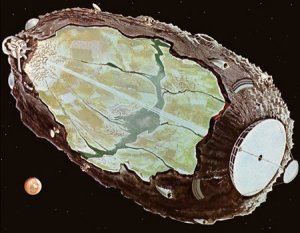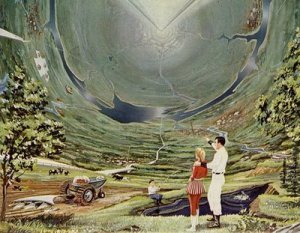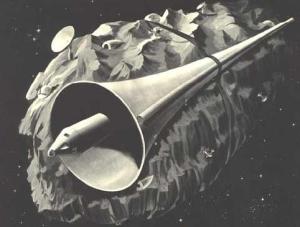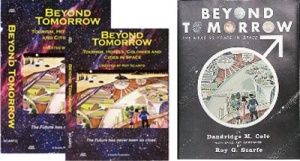 NASA is again considering the feasibility of manned missions to the asteroids. However, this idea is not without precedent. Scientists began seriously considering asteroids as targets of exploration in the 1960s. The leading proponent of such missions was American aerospace engineer and futurist – Dandridge MacFarland Cole.
NASA is again considering the feasibility of manned missions to the asteroids. However, this idea is not without precedent. Scientists began seriously considering asteroids as targets of exploration in the 1960s. The leading proponent of such missions was American aerospace engineer and futurist – Dandridge MacFarland Cole.
October 30th, 2005 marked the 40th anniversary of his untimely passing. Dandridge Cole was only 44 years old when he suffered a fatal heart attack. The anniversary of his death seems to have largely escaped the notice and attention of the space community at large. This brief article seeks to redress that awful oversight.
NASA and the aerospace community owe an enormous debt to this great man. In his book ‘Islands in Space: The Challenge of the Planetoids’, co-authored with Donald Cox, he laid the foundation for much of our current thinking on the Exploration, Mining, and Colonization of the Asteroids.
Cole and Cox, from the vantage point of 1964, had foreseen the great wilderness that lay ahead of the U.S. space program after the Apollo program had achieved its objective of placing a man on the Moon. They had predicted, unlike many of their contemporises that a great hiatus laid between the first lunar landing and the eventual goal of landing men on Mars. A full decade of technological development would stall the American Space program until the super boosters and nuclear engines, needed to take astronauts to Mars, replaced the Saturn 5. Until these technical milestones were achieved, they felt that a manned mission to the Asteroids should be seriously considered as the next logical goal for the post-Apollo era.
Recently, within NASA there has been ongoing discussion of the possibility of mounting a manned voyage to a Near-Earth Object (NEO). Its advocates are certain of the tremendous scientific return of such an undertaking. Dandridge Cole was one of the first scientists to draw the broad outlines of such a mission. In the early 1960s, he studied the possibility of using Apollo hardware for a mission to Eros, during its close approach to Earth in 1975.
Cole and Cox also outlined many of the robotic precursor missions to the asteroids that have largely inspired those that were realised over the past few years (such as NEAR and Hayabusa) and those yet to be flown (such as the Dawn mission to Ceres and Vesta). In addition, they saw the importance of establishing beachheads on the Martian moons Phobos and Demos to facilitate the exploration of the planet.
In 1963, Cole wrote ‘Exploring the Secrets of Space: Astronautics for the Layman’ with I. M. Levitt. In this book they suggested hollowing out an ellipsoidal asteroid about 30 km long, and rotating it about its major axis to simulate gravity. By reflecting sunlight inside with mirrors, and creating, on its inner surface, a pastoral setting an asteroid could be transformed into a permanent space colony. Cole and Cox also envisioned that asteroids would provide the raw materials to form the basis of a spacefaring civilization. And, that asteroidal materials would also serve terrestrial needs. In their view these materials could be transported using mass drivers or linear motors. Cole’s work largely presages that of Gerard K. O’Neill by more than a decade.
A year later, Cole and Cox elaborated this idea further. They went on to consider the possibility of using asteroids as interstellar arks or generation ships. The “nomadic pseudo-earth,” as Cole and Cox called their conception, would be the hollowed out space inside a captured asteroid. The result would be a “gigantic geodesic interior chamber,” created “in much the same way as a glassblower shapes a small solid lump of molten glass into a large empty bottle.” Thus Cole, like Konstantin Tsiolkovsky and Robert Goddard before him, envisaged that asteroids would be the stepping-stones paving the path to the outer solar system and beyond. Cole in his 1961 book ‘The Ultimate Human Society’ also argued that huge space colonies might evolve into new organisms called “Macro-Life” composed of innumerable living creatures. Cole wrote:
“Taking man as representative of multicelled life, we can say that man is the mean proportional between Macro-Life and the cell. Macro-Life is a new life form of gigantic size which has for its cells individual human beings, plants, animals, and machines . . . Society can be said to pregnant with a mutant creature which will be at the same time an extraterrestrial colony of human beings and a new large-scale life form.”
A Time magazine article from January 1961 provides a very interesting profile of Dandridge Cole during this period of his life.
In 1965, Cole co-authored with Roy Scarfo, ‘Beyond Tomorrow: The Next 50 Years in Space’ in which he proposed various other space projects and the use of cryogenics so that individuals could travel great distances while in a state of suspended animation.
Considering Dandridge Cole’s many accomplishments, why is there such an enormous dearth in the number of websites devoted to the memory of this great visionary? I had the great privilege of meeting Donald Cox at the National Space Society’s 1996 International Space Development Congress (ISDC) in New York City. He graciously autographed my copy of ‘Islands in Space’. We spent the better part of fifteen minutes discussing the valuable insights, he and Cole discussed in that book and how it pertained to humanity’s future in space. It is one of my most cherished possessions. In fact, I consider ‘Islands in Space’ a very seminal work in the history of astronautics and should be republished along side other great works in the field.



In 1979 Harper & Row published my novel, Macrolife, which pays tribute to Cole. It was much praised by Arthur C. Clarke and Gerard O’Neill, and chosen by Library Journal as one of the hundred Best SF Novels of all time. It has just been reissued, with updates by Pyr Books, a division of Prometheus.George Zebrowski
HiThanks for the links to the artwork. I have so wondered where the originals of some of those came from – now I know. He was incredibly optimistic about space-flight, which only economies of scale make practical, like the “Aldebaran”.BTW I loved “Macrolife” George Z., though I wasn’t so keen on “Cave of Stars” – was too much like an Alexei Panishin novel I’d disliked to really enjoy.
Thank you for the fine article on my father.You mention meeting Don Cox and also the idea that it would be good to republish Islands in Space. Are you aware that something of the sort was done? In 1996 Don Cox contacted another old friend of both himself and my father, Jim Chestek, and together they published “Doomsday Asteroid” (admittedly a more sensational title!) Capitalizing on recent interest in and concern about asteroid impacts, it draws on and updates the older book.And apropos of Mr. Zebrowski’s interesting novel, Macrolife (of which I have an early copy – perhaps I should get the new edition) I might also mention his Sunspacers trilogy and Skylife, which he co-edited. These both also reflect or allude to the realms that my father envisioned.
You might be interested in a blog posting “Gardening in microgravity” about the practicalities of growing plants for long-term space travel: http://cabiblog.typepad.com/hand_picked/2007/10/gardening-in-mi.html
I read "Islands in Space" when I was very young and it ignited my imagination from the start. Cole was indeed a visionary. I also have Doomsday Asteroid and it updates some of the original material from "Islands in Space". I also wrote my Master's thesis on the potential economic use of the Asteroids. There is so much waiting for us in the asteroid belt and little gravity to keep us from acquiring this material.I think that DAWN is a good start but we need to launch about a dozen satellites to the asteroid belt and put them into retrograde orbits. That way we can encounter and study a greater number of objects in a shorter amount of time. When scientific study has finished, the economic exploitation of the asteroids will begin and it will continue for thousands of years. Some of the first space colonies will be created for workers in the asteroid belt.
Dandridge Cole was indeed a great visionary. I first became acquainted with his work in the early 1990s. More has to be done to honour his memory!!!!
Great article. My only concern is credit should be given for the visionary artwork of Roy Scarfo, which helped give life to these ideas to the public. His works shown here were inspirational to me as a child. In the 70's I was fortunate enough to work with O'Neill in painting the interiors of this later generation of proposed giant space habitats. The role of artists in helping to convey the specifics as well as a wider 'vision' of space scenarios is fairly common in recent history, such as the collaborations of Chesley Bonestell /Willy Ley and Von Braun, R.A. Smith/Arthur C. Clarke, and others. I want to give Roy his due on this one.
I have been looking and reading other articles about Islands in Space: The Challenge of the Planetoids, and yours is the one with the most interesting, accurate and useful information. Thanks for sharing and have a nice day.generic viagra
I was enormously excited when in 1963 I read the scientific yet visionary writings of Dandridge M. Cole. Then re-excited in 1979 when George Zebrowski published his novel, Macrolife, which pays tribute to Cole. It was much praised by Arthur C. Clarke (my co-editor and friend) and Gerard O'Neill (whom I spoke to about this in 1973-1977).